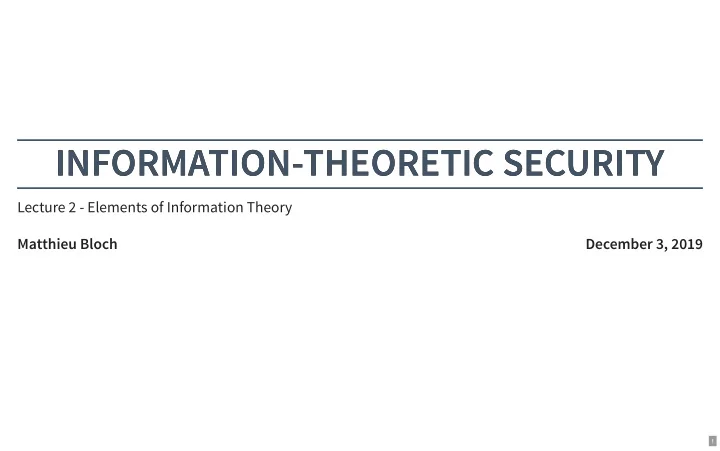

INFORMATION-THEORETIC SECURITY INFORMATION-THEORETIC SECURITY Lecture 2 - Elements of Information Theory Matthieu Bloch December 3, 2019 1
TOOLS: TOOLS: CONCENTRATION INEQUALITIES CONCENTRATION INEQUALITIES Lemma (Markov's inequality) Let be a non-negative real-valued random variable. Then for all X t > 0 E [ X ] P ( X ≥ t ) ≤ . t Lemma (Chebyshev's inequality) Let be a real-valued random variable. Then for all X t > 0 Var( X ) P (| X − E [ X ]| ≥ t ) ≤ . t 2 Proposition (Weak law of large numbers) Let be i.i.d. real-valued random variables with finite mean and finite variance . Then σ 2 { X i } n μ i =1 n n σ 2 ∣ ∣ ∣ ∣ ∣ 1 ∣ 1 P ( n ∑ X i − μ ≥ ϵ ) ≤ ∣ n →∞ P lim ( N ∑ X i − μ ≥ ϵ ) = 0. ∣ nϵ 2 ∣ ∣ ∣ ∣ i =1 i =1 2
3
4
5
TOOLS: TOOLS: MORE CONCENTRATION INEQUALITIES MORE CONCENTRATION INEQUALITIES Proposition (Hoeffding's inequality) Let be i.i.d. real-valued zero-mean random variables such that . Then for all { X i } n X i ∈ [ a i b i ; ] i =1 ϵ > 0 n 2 n 2 ϵ 2 ∣ ∣ ∣ 1 P ( n ∑ X i ∣ ≥ ϵ ) ≤ 2 exp ( − ) . ∑ n a i ) 2 i =1 b i ( − ∣ ∣ i =1 More on concentration inequalities later in the course when we need more precise results Lemma. Let and . If then there exists such that . f : X → R + x ∗ x ∗ ϵ > 0 E X [ f ( X )] ≤ ϵ ∈ X f ( ) ≤ 2 ϵ 6
7
8
CHANNEL CODING CHANNEL CODING One shot channel coding Coding consists of encoder and decoder Enc : [1; M ] → X Dec : Y → [1; M ] Objective: transmit messages with small average probability of error W M 1 ˆ P e ( C ) ≜ P W ( ≠ W | C ) = M ∑ P (Dec( Y ) ≠ m | W = m ) m =1 Lemma (Random coding for channel reliability) For and , define ∈ Δ( X ) γ > 0 p X p Y ≜ W ∘ p X W Y | X ( y | x ) A γ ≜ { ( x , y ) ∈ X × Y : log ≥ γ } . p Y ( y ) For a codebook of independently generated codewords , we have C X i ∼ p X 2 − γ E C P e [ ( C )] ≤ P p X W Y | X (( X , Y ) ∉ A γ ) + M . One shot result not tight but good enough for many problems 9
10
11
12
CHANNEL CODING CHANNEL CODING Reliable communication over a noisy channel Introduce coding over blocklength , so that and n ∈ N ∗ Enc : [1; M ] → X n Y n Dec : → [1; M ] Definition. (Achievable rate) A rate is achievable if there exists a sequence of codes with length with R n 1 log M ≥ R ( ) = 0 lim inf lim sup n →∞ P e C n n →∞ n Proposition (Achievability) The rate is achievable. max p X I ( X ; Y ) Proposition (Converse) All achievable rates must satisfy . R R ≤ max p X I ( X ; Y ) This provides an operational meaning to the channel capacity . C ≜ max p X I ( X ; Y ) 13
14
Recommend
More recommend